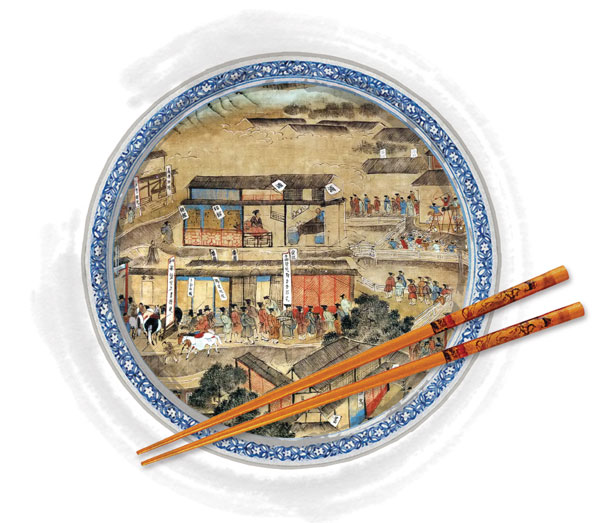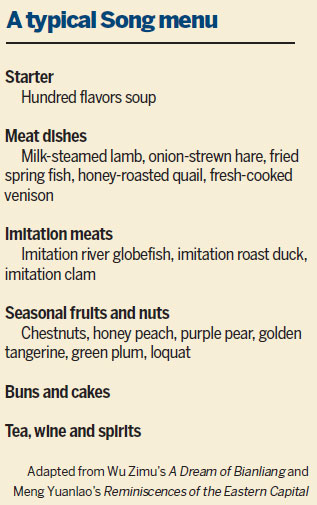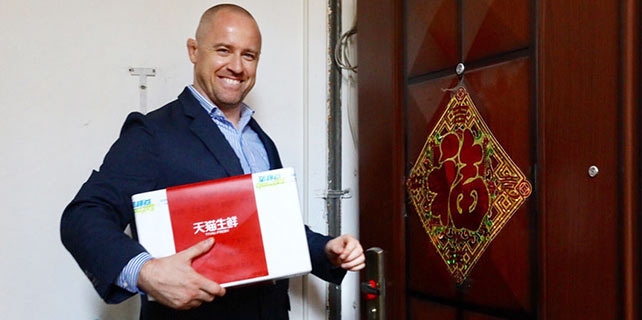The birth of gourmet culture
An 11th-century dynasty gave the world the modern restaurant - complete with menus, waiters and the feudal version of Michelin stars
So you want to start a restaurant in China - circa the 10th century.
This isn't a bad idea. The timing is perfect: In 965 Emperor Taizong of the Song Dynasty (960-1279) (宋太宗, sòng tài zōng) lifted 宵禁(xiāo jìn, the curfew laws that had suppressed nightlife across Chinese capitals during predecessor dynasties). Suddenly, in the Song capital of Bianliang (present-day Kaifeng, Henan province), "night markets stayed open until midnight and resumed at dawn, and there was mischief all night long", wrote 12th-century gourmand Meng Yuanlao (孟元老) in Reminiscences of the Eastern Capital (《东京梦华录》, dōng jīng mèng huá lù).


Location is everything. According to Meng's contemporary the historian Cai Tao (蔡绦), Bianliang had a dedicated street "teeming with night markets and restaurants... carriages and crowds, and lanterns that lit up the sky", even keeping away mosquitoes and flies.
By the 12th century, the new Song capital, Lin'an (present-day Hangzhou, Zhejiang province), had replaced Bianliang as the world's largest city, with about 1 million inhabitants. The party didn't end, though: "On the main street of Lin'an, there was commerce day and night," Lin'an native Wu Zimu (吴自牧) recalled in his memoirs, listing roughly 600 dishes found in the capital's hundreds of teahouses, bars, high-end restaurants and noodle shops.
Song restaurants even had their own star rating system - as Lu Zhishen (鲁智深), a maverick monk from the 14th-century novel Water Margin (《水浒传》, shuǐ hǔ zhuàn), finds out the hard way. Leaving his monastery for a drink one evening, Lu is rejected at every watering hole in town, his alcohol-starved brain taunted by rows of "tavern flags jutting from the eaves". Eventually he finds a dive "deep among the apricot blossoms at the edge of town", hung with only a grass curtain, and willing to serve meat and alcohol to the Buddhist monk.
Adapted from military flags, the tavern flag (酒旗, jiǔ qí) - also known as 酒望 (jiǔ wàng, tavern streamer), 酒幌 (jiǔ huǎng, tavern drape), or锦旆 (jǐn pèi, brocade flag) - had become common business advertising by the eighth century. An eatery dishing up one or two specialties might put up just one 酒旗 inscribed with its name or main product, but a sit-down restaurant with a menu had to have at least a second flag.
Three flags were never used - three drapes being a homonym for dishonesty - but four indicated that the chef had mastered a regional culinary style. At a five-flag restaurant, banqueting officials, reveling merchants and even ordinary diners could command dishes from anywhere in China to their table.
In fact, according to economist Nicholas Kiefer, Song innovations like menus and table service were the prototype of the modern restaurant. Kiefer stipulated in a 2011 Cornell University quarterly that public dining usually only took place at inns, where traveling strangers gathered at set mealtimes and ate whatever was served. In China, the earliest recorded inns were actually state-operated roadhouses (驿站, yì zhàn) that housed and fed officials on work-related journeys before the 11th century BC.
Privately run visiting houses appeared in the Han Dynasty (206 BC-220 AD), catering to lower-class itinerants; "craftsmen, doctors, fortunetellers, healers, peddlers and businessmen all plied their trade in the visiting houses," stated the Book of the Han (《汉书》, hàn shū). However, urbanization and the rise of commerce in the Song Dynasty changed the image of public eateries: State-run and privately owned 酒楼 (jiǔ lóu, wine mansions), usually the only multistory buildings in the neighborhood, were patronized by literati, who ate upstairs in one of dozens of private dining rooms and were given ink and brushes should the spirit (or spirits) move them to compose poetry as they supped.

With the location picked and flags unfurled, it was time to hire staff. Waiters - known as "shop's No 2" (店小二, diàn xiǎo èr) - were the linchpins for the fast-paced 酒楼. "The men of Kaifeng were extravagant and indulgent. They would shout their orders by the hundreds: Some wanted items cooked and some chilled, some heated and some prepared, and some iced or delicate or fat. ... The waiter ... carried (the orders) in his head, and sang them when he got into the kitchen," Meng wrote. "In an instant, the waiter would be back, carrying three dishes forked in his left hand, while on his right arm from hand to shoulder he carried about 20 bowls doubled up, and he distributed them precisely as everyone had ordered without an omission or mistake."
Private rooms in Hangzhou's 酒楼 were served by wine courtesans "all dressed colorfully, each competing to smile more brightly than the other", as described in The Affairs of Wulin, a 13th-century memoir. There were also "young girls whom nobody ordered" running into the rooms to sing or loudly recite poetry for attention, as well as musicians, acrobats and even connoisseur courtesans who helped the guests pick out their wine.
Despite these opulent dressings, 酒楼 and mischief went hand-in-glove in the public's imagination: In Water Margin, heroes Song Jiang (宋江) and Chai Jin (柴进) are eating in a private 酒楼 room when they hear a disturbance next door. Rushing in, they find Shi Jin (史进), a tattooed fellow outlaw, soused and swearing - the start of a chain reaction that culminates in an all-out brawl in the capital.
Song era 酒楼 "went in and out of fashion regularly", according to Meng, but conquest from the northern tribes finally brought down the curtain on debauchery in Bianliang in the 12th century, then Lin'an a century later. Gourmet culture, though, persisted: Marco Polo referred to full-service restaurants during the Yuan Dynasty (1271-1368), and missionary John Henry Gray wrote of 19th-century businesses similar to the Song's 酒楼: a set of private apartments over a public dining room above a ground-floor kitchen, displaying the chef's skill and fresh ingredients "to persons in all classes of society ... rich and poor".
Courtesy of The World of Chinese; www.theworldofchinese.com.cn
The World of Chinese
(China Daily Africa Weekly 10/05/2018 page23)
















